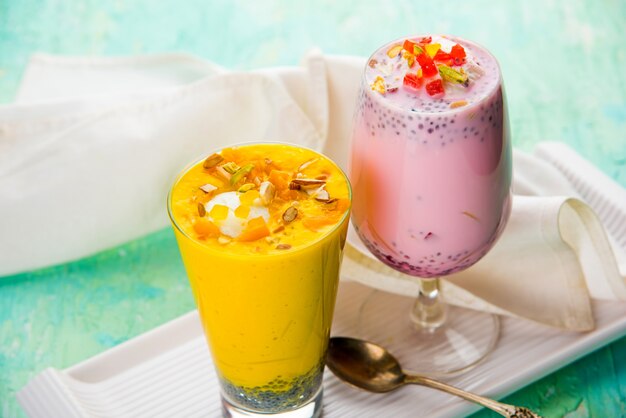Falooda is an exquisite, multi-layered dessert drink that hails from the Indian subcontinent and is enjoyed across South Asia and the Middle East. With its vibrant colors, unique textures, and delightful flavors, this drink is not only refreshing but also an experience for the senses. Whether you’re looking for a cool treat on a hot day or want to try your hand at making a traditional South Asian delicacy, falooda is a perfect choice. Let’s explore what makes falooda special and how you can make it at home.
What is Falooda?
Falooda is a rich, layered drink traditionally made from a combination of ingredients such as sweet basil seeds (sabja or tukmaria), vermicelli noodles, rose syrup, milk, and ice cream. Often topped with a scoop of ice cream and garnished with nuts or fruit, falooda offers a wonderful blend of sweetness, creaminess, and chewiness that makes it stand out from other desserts. It’s believed to have originated in the Mughal Empire, blending Persian and Indian culinary influences, and has become a beloved treat in many parts of Asia.
Key Ingredients of Falooda
- Basil Seeds (Sabja/Tukmaria): These tiny seeds are soaked in water until they swell, creating a gelatinous texture that adds a delightful chewiness.
- Falooda Vermicelli: Special thin noodles made from cornstarch or wheat, cooked until soft and translucent.
- Rose Syrup: This fragrant syrup gives falooda its distinctive pink color and sweet floral taste.
- Milk: Chilled, full-fat milk is ideal for a creamy consistency.
- Ice Cream: Typically vanilla or kulfi (a type of Indian ice cream), added as a finishing touch.
- Toppings: Chopped pistachios, almonds, or jelly cubes can be used for garnish.
How to Make Falooda at Home
Creating this drink at home is simpler than you might think. Here’s a step-by-step guide:
Ingredients:
- 2 tablespoons of basil seeds (sabja/tukmaria)
- ½ cup of falooda vermicelli
- 2 cups of chilled whole milk
- 3 tablespoons of rose syrup
- 2 scoops of vanilla ice cream or kulfi
- Chopped pistachios or almonds (optional for garnish)
- Jelly cubes (optional)
Instructions:
Prepare the Basil Seeds:
- Soak the basil seeds in water for about 10–15 minutes until they expand and develop a jelly-like coating. Drain and set aside.
Cook the Vermicelli:
- Boil the falooda vermicelli according to the package instructions, typically for 3–5 minutes or until they are soft. Drain and rinse under cold water to prevent sticking.
Assemble the Falooda:
- In a tall glass, start by layering a tablespoon of the soaked basil seeds.
- Add a few spoonfuls of the cooked vermicelli.
- Pour in about 1 to 1.5 tablespoons of rose syrup, adjusting to your desired level of sweetness.
- Gently pour in the chilled milk until the glass is nearly full.
Top with Ice Cream and Garnish:
- Place a scoop of vanilla ice cream or kulfi on top.
- Sprinkle with chopped pistachios or almonds for added crunch.
- Add a few jelly cubes for extra color and texture if desired.
Serve Immediately:
- Serve with a long spoon and a straw, allowing your guests to mix the layers as they enjoy.
Variations and Tips
- Flavor Twists: Try using mango syrup or adding fruit purées for a different spin on traditional falooda.
- Vegan Option: Substitute dairy milk with almond or coconut milk and use vegan ice cream.
- Extra Texture: Chia seeds can be used as an alternative to basil seeds for a similar chewy texture.
- Presentation: Serve in a clear glass to showcase the beautiful layers of pink syrup, white milk, basil seeds, and noodles.
Why You Should Try Falooda
Falooda is more than just a drink; it’s a celebration of flavors and textures that showcases the richness of South Asian culinary traditions. The combination of creamy, floral, and chewy elements creates a unique sensory experience that’s as delightful to drink as it is to look at. Perfect for summer days, festive occasions, or whenever you’re in the mood for something exotic, falooda is a dessert drink that is sure to impress.
Making falooda at home allows you to experiment with ingredients and tailor it to your taste. With a few simple steps, you can create this vibrant treat and enjoy a taste of South Asia right in your own kitchen.








